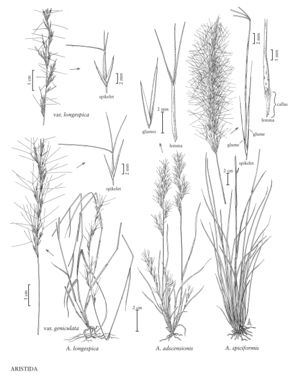Difference between revisions of "Aristida spiciformis"
imported>Volume Importer |
imported>Volume Importer |
||
| Line 39: | Line 39: | ||
|publication year= | |publication year= | ||
|special status= | |special status= | ||
| − | |source xml=https://bitbucket.org/aafc-mbb/fna-data-curation/src/ | + | |source xml=https://bitbucket.org/aafc-mbb/fna-data-curation/src/200273ad09963decb8fc72550212de541d86569d/coarse_grained_fna_xml/V25/V25_1009.xml |
|subfamily=Poaceae subfam. Aristidoideae | |subfamily=Poaceae subfam. Aristidoideae | ||
|tribe=Poaceae tribe Aristideae | |tribe=Poaceae tribe Aristideae | ||
Latest revision as of 18:55, 11 May 2021
Plants perennial; cespitose. Culms 45-100 cm, unbranched or sparingly branched. Leaves cauline; sheaths shorter than the internodes, glabrous except for occasional hairs at the summit; collars glabrous, or with a few pilose hairs at the sides; ligules about 0.5 mm; blades 12-28 cm long, 1-3 mm wide, usually folded or loosely involute, light yellow-green, glabrous abaxially, puberulent adaxially. Inflorescences dense panicles, (3)8-24 cm long, 2-4 cm wide, somewhat spirally twisted in age; nodes glabrous or strigillose, hairs about 0.1 mm; primary branches 2-4 cm, tightly appressed, without axillary pulvini, with 6-10 spikelets per branch. Glumes lanceolate, 1-veined; lower glumes 3.5-4.5 mm, abruptly contracted to a 4-12 mm awn; upper glumes 7-10 mm, gradually narrowed to a 10-12 mm awn; calluses about 2 mm; lemmas 5-6 mm, dark brown or purplish, terminating in a straight or twisted beak 7-30 mm long, about 0.2 mm wide, beak often disarticulating, no obvious zone of articulation developed, junction of the beak and awns sometimes evident; awns usually unequal, strongly curved and twisted at the base, straight distally, sometimes disarticulating at maturity; central awns (10)20-30 mm; lateral awns 10-20(25) mm, at least 1/2 as long as and evidently thinner than the central awns; anthers 3, about 1 mm, brown. Caryopses 4-5 mm, including the delicate style column. 2n = unknown.
Distribution
Puerto Rico, Ga., Tex., N.C., Ala., Miss., S.C., Fla.
Discussion
Aristida spiciformis grows in pine savannahs, pine flatwoods, pine-oak sandhills, and oak woods, frequently being associated with Pinus palustris. It is a primary fire carrier in these habitats. Its range includes Cuba and Puerto Rico as well as the southeastern United States.
Selected References
None.
